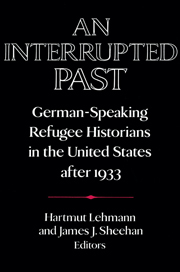Book contents
- Frontmatter
- Introduction
- PART I: Introduction
- 1 German and American Historiography in the Nineteenth and Twentieth Centuries
- 2 German Historiography during the Weimar Republic and the Émigré Historians
- 3 The Historical Seminar of the University of Berlin in the Twenties
- PART II: Introduction
- 4 Refugee Historians in America: Preemigration Germany to 1939
- 5 “Uphill Work”: The German Refugee Historians and American Institutions of Higher Learning
- 6 Everyday Life and Emigration: The Role of Women
- 7 The Special Case of Austrian Refugee Historians
- 8 Schicksalsgeschichte: Refugee Historians in the United States
- 9 German Historians in the Office of Strategic Services
- 10 The Refugee Scholar as Intellectual Educator: A Student's Recollections
- PART III: Introduction
- 11 German Émigré Historians in America: The Fifties, Sixties, and Seventies
- 12 The Americanization of Hajo Holborn
- 13 Explaining History: Hans Rosenberg
- 14 Ernst Kantorowicz and Theodor E. Mommsen
- 15 Refugee Historians and the German Historical Profession between 1950 and 1970
- Conclusion
- Index
9 - German Historians in the Office of Strategic Services
Published online by Cambridge University Press: 05 January 2013
- Frontmatter
- Introduction
- PART I: Introduction
- 1 German and American Historiography in the Nineteenth and Twentieth Centuries
- 2 German Historiography during the Weimar Republic and the Émigré Historians
- 3 The Historical Seminar of the University of Berlin in the Twenties
- PART II: Introduction
- 4 Refugee Historians in America: Preemigration Germany to 1939
- 5 “Uphill Work”: The German Refugee Historians and American Institutions of Higher Learning
- 6 Everyday Life and Emigration: The Role of Women
- 7 The Special Case of Austrian Refugee Historians
- 8 Schicksalsgeschichte: Refugee Historians in the United States
- 9 German Historians in the Office of Strategic Services
- 10 The Refugee Scholar as Intellectual Educator: A Student's Recollections
- PART III: Introduction
- 11 German Émigré Historians in America: The Fifties, Sixties, and Seventies
- 12 The Americanization of Hajo Holborn
- 13 Explaining History: Hans Rosenberg
- 14 Ernst Kantorowicz and Theodor E. Mommsen
- 15 Refugee Historians and the German Historical Profession between 1950 and 1970
- Conclusion
- Index
Summary
There is a perverse sense in which modern physics was the great beneficiary of the regime that expelled the physicists from Germany, and we all know the story of how they exacted a terrible revenge. The same may be said, mutatis mutandis, of historical scholarship and of the German historical scholars driven out of Europe in the 1930s. The historians' Manhattan Project was the Research and Analysis Branch of the wartime Office of Strategic Services (OSS). Although the impact of the refugee historians on World War II would prove to be somewhat less explosive, the analogy is profoundly suggestive, even slightly inspiring. Like their counterparts in the physical sciences, the humanist scholars of OSS were given an unprecedented opportunity to contribute to the anti-fascist struggle, not in spite of their academic training but precisely on the basis of it.
The groundwork of America's first central intelligence agency was laid by a presidential order of June 1941 in which President Roosevelt created an office charged with the collection, evaluation, and distribution of foreign intelligence. Although OSS became most famous for the overseas exploits of its “operational” branches, Gen. William Donovan, who directed the organization throughout its brief lifetime, always acknowledged that the heart of America's first intelligence agency lay in its essentially academic functions of research and analysis.
- Type
- Chapter
- Information
- An Interrupted PastGerman-Speaking Refugee Historians in the United States after 1933, pp. 136 - 139Publisher: Cambridge University PressPrint publication year: 1991
- 1
- Cited by

